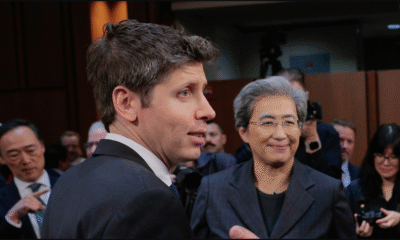Trump Presidency
iPhone Shock: Trump Tariffs Send China Shipments to US Crashing to 14-Year Low
Chinese shipments of Apple’s iPhones to the United States plunged to their lowest levels since 2011 in April, underscoring the disruptive effects of President Donald Trump’s tariff campaign on global tech supply chains. According to Chinese customs data, smartphone exports to the US fell a staggering 72% last month, amounting to under $700 million.
The Port of Los Angeles—the busiest container hub in the U.S.—reported a 30% drop in inbound shipments during the first week of May, highlighting the swift impact of Trump tariffs on trade flow. “Fewer containers mean less work on the waterfront, from longshoremen to truckers and warehouse workers,” said Gene Seroka, the port’s Executive Director.
The shockwaves have reverberated across corporate America and global markets. JPMorgan CEO Jamie Dimon warned of rising risks of inflation and even stagflation. “The odds of stagflation are probably two times what the market expects,” he cautioned. Citigroup CEO Jane Fraser echoed similar concerns, noting that tariff uncertainty has caused companies to delay critical investments.
Retailers are already bracing for impact. Walmart warned that prices will rise, prompting Trump to respond by urging the company to “eat the tariffs”—a position at odds with earlier claims that exporters, not US companies, would bear the costs. However, academic research and real-world data increasingly show that American businesses and consumers are footing the bill.
In response, some global retailers are exploring ways to distribute tariff-related price hikes across international markets. Firms like Birkenstock and Pandora are considering modest increases in Europe and other regions to avoid steep price jumps in the U.S. This approach, however, risks spreading inflation to economies just beginning to stabilise.
Meanwhile, the administration has threatened to reimpose Trump tariffs at full strength if trading partners don’t finalise new deals during the current 90-day truce. Treasury Secretary Scott Bessent confirmed that tariff rates could revert to their April 2 levels—some as high as 145%—if negotiations stall. Trump himself stated, “It’s not possible to meet the number of people who want to see us,” suggesting a limited capacity to handle simultaneous negotiations with all key partners.
The impact is global. General Motors has announced it will stop exporting vehicles to China from the U.S., citing “significant changes to economic conditions.” And in Beijing, officials accused Washington of undermining trade talks by issuing a new warning against using Huawei’s AI chips under U.S. export controls.
Adding to the uncertainty, China has maintained its export controls on rare earth minerals despite pledging to ease non-tariff barriers during recent Geneva negotiations. To stabilise its economy, China cut key interest rates for the first time since October, aiming to stimulate consumer demand and credit flow.
A recent survey by Allianz Trade found that 42% of exporters worldwide expect their revenues to decline due to the tariff escalation. Policy volatility, supply chain disruptions, and deepening economic uncertainty continue to cloud the future of global trade.
As tariff battles intensify, one thing is clear: the cost of trade conflict is becoming harder to ignore.
Apple’s Foldable iPhone: Will the ‘iPhone Flip’ Finally Arrive by 2026?










































Pingback: Apple Just Defied Trump — And Is Betting Big on India Anyway
Pingback: iPhone 17 Leak Shocker: Slimmer, Smarter, and Pricier Than Ever?